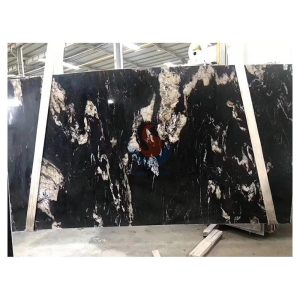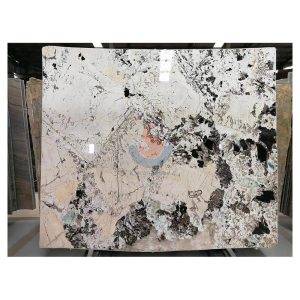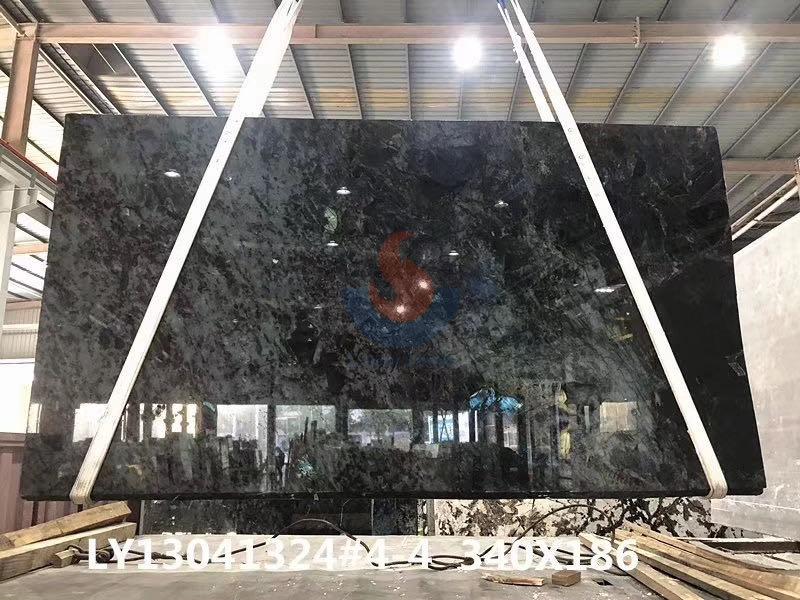Granite countertops have become the material of choice for many home kitchen and bathroom renovations due to their natural beauty and durability. Though many individuals value granite counters’ ease of use, they sometimes forget about its upkeep requirements. Granite countertops’ lifetime can be extended, their gloss maintained, and stains from seeping in stopped by sealing. How then often should granite counters be sealed? The frequency of sealing varies on a number of elements, including the type of granite, how often it is used, and how it is maintained, hence there is no one straightforward response to this subject. By exploring these elements to make sure your granite countertops stays as good as new after many years of use, this article will assist you know how to properly maintain them.

Brazilian black sea wave Titanium Granite cosmic black granite
The Nature of Granite and the Importance of Sealing
First, we need to understand the basic properties of granite. Granite is a naturally occurring stone featuring a tiny porous structure. These tiny holes can absorb liquids such oil, red wine, or lemon juice, which results in challenging-to-remove stains or discoloration on the countertop. Sealants play the function of filling these small holes and creating a protective coating to stop liquids from seeping in, so preserving the structural integrity and beauty of the countertop.
However, not all granite countertops need to be sealed. Certain high-density granite varieties, notably black granite, have minimal porosity and are inherently impervious to penetration. This kind of granite could only need one seal during installation, and the frequency of sealing could be reduced. Because of their bigger pores, some lighter-colored or more textured granites often require more frequent sealing.
How to tell if a granite countertop needs to be sealed
You may easily “water drop test” a granite countertop to see whether it need sealing. The particular technique is to drop a few drops of water on the countertop, wait ten to fifteen minutes, and then check the water drop status. Should the water droplets stay whole, the countertop is in good shape and requires no immediate resealing; should the water droplets split out and affect the stone, the seal has failed and must be resealed.
In addition to the water drop test, you can also observe the changes in the appearance of the countertop. Should you discover that the countertop starts to seem dull, shows difficult-to-remove stains, or feels that the surface has grown rough, these could be indicators of a failing seal. In this instance, it’s advised to reseal the countertop right away.
Frequency of granite countertop sealing
How then often should granite countertops be sealed? The response to this question differs depending on numerous elements and is unique for each individual:
Granite type: As mentioned above, different types of granite require different sealing requirements. While denser dark granite can be sealed every two to three years, generally speaking lighter or more porous granite requires one annual seal-off.
Kitchen granite countertops typically need to be sealed more often since the kitchen is one of the most often used spaces in the house and oil stains, seasonings, water stains, etc. often come into touch with the countertop when cooking. It is advised to seal the countertop every six to twelve months if it is routinely exposed to strong oil or acidic products. Bathroom counters’ quite modest frequency of use makes them only sealed once every two years.
Maintenance habits: If you usually maintain the granite countertop properly, avoid contact with corrosive substances, and clean up spilled liquids in time, the countertop’s sealing layer may last longer and the corresponding sealing frequency can be reduced.
Generally speaking, most households can set the sealing frequency of granite counters to once a year, which guarantees complete protection of the countertop without waste of resources resulting from too frequent sealing.
How to Properly Seal Granite Countertops
The process of sealing granite countertops is relatively simple, but there are some basic steps to follow to ensure the best results. For reference, here is a standard sealing technique:
Cleaning the countertop: Before sealing, the countertop must be thoroughly cleaned. To totally eliminate stains, oils, and other debris from the countertop, use a moderate stone cleaner in warm water. To guarantee the surface is entirely dry, then sweep the countertop with a fresh cloth.
Choose the right sealer: There are many sealers available on the market, including water-based sealers and solvent-based sealers. While solvent-based sealers offer stronger penetration and are appropriate for less dense and more porous granite, water-based sealers are environmentally friendly and easy to use, fit for regular household use. Choose a sealer depending on the type of countertop you have.
Apply sealer evenly: Apply sealer evenly to the countertop, making sure to cover all surfaces. Apply the sealer using a soft cloth, sponge, or brush to guarantee that it can equally pierce granite’s pores. To guarantee full absorption, let the sealer lie on the countertop for ten to fifteen minutes following application.
After the sealant has settled, wipe any extra sealant off the countertop using a fresh, soft cloth to prevent leaving stains or spots on the surface. This stage is crucial since unwiped sealant will leave a residue that is challenging to remove following drying.
Make sure the sealant is entirely dry before the countertop is placed back into use. Usually taking 24 hours, the particular time can be found in the directions of the sealant.
After the sealing is finished, routinely do a water drop test to track the sealing action. Additional sealing should be done in time should the weakening of the sealing effect be discovered.
Common sealing misunderstandings
There are several common misunderstandings that need to be avoided in the process of sealing granite countertops to ensure the best sealing effect.
Over-sealing: Some people think that the more frequent the sealing, the better. Actually, over-sealing could make the countertop’s surface seem sticky or lose its sheen. Consequently, genuine needs should guide the frequency of sealing. Only time and money will be wasted by oversealing.
Ignore edges and seams: When sealing, edges and seams are often easily overlooked. These sections are similarly prone to liquid erosion, hence particular care should be given to them while sealing to guarantee that the sealer covers them equally.
Using inappropriate cleaners: Sealed countertops should be cleaned daily with a special stone cleaner instead of ordinary household cleaners. Ingredients in ordinary cleansers could be either alkaline or acidic, which will reduce the sealant’s effectiveness.
Ignoring the sealant’s shelf life: Sealants also have a shelf life; outdated sealants could be less effective. Check the sealant’s shelf life thus to be sure it is fresh and efficient before applying it.

Factory direct low price luxury marble patagonia marble granite slab translucent pandora quarzite white onyx
Sealing granite countertops is an important part of maintaining its beauty and durability, but it is not a tedious task that needs to be performed frequently. You may quickly maintain the countertop sparkling and clean and extend its service life by routinely doing water drop tests, selecting sealants properly, and creating a suitable sealing plan depending on the type of granite and frequency of usage. Generally speaking, the frequency of sealing once a year is sufficient to meet the needs of most families, but it should also be adjusted according to actual conditions. Granite countertops will become a long-lasting highlight in your house joining you through many fantastic cooking occasions as long as you learn the right sealing techniques and maintenance methods.





